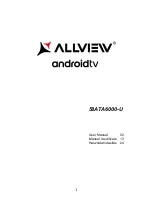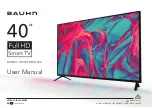
Circuit Description
9.
After processing, the Y/C outputs (pins 25 and 23) are both
filtered by a low-pass filter, in order to eliminate the high
frequency harmonics of this system clock.
After filtering, the Y and C signals are fed to the source inputs
of the UOC (pins 44 and 45).
Specification
If the comb filter is 'on', and the signal level drops below a
specified value, then the filter is set to 'off'. Once the filter is set
to 'off' it will remain 'off' until a channel change is performed.
When an S-Video (Y/C) or component video signal is offered to
the TV, the filter is bypassed via the 'COMB_BYPASS' signal
from the microprocessor.
9.3.5
Video Demodulation
The color decoder circuit detects whether the signal is a PAL,
NTSC, or SECAM signal. The result is made known to the auto
system manager. The PAL/NTSC decoder has an internal
clock generator, which is stabilized to the required frequency
by using the 12 MHz clock signal from the reference oscillator
of the microcontroller / teletext decoder.
The base-band delay line is used to obtain a good suppression
of cross color effects.
The Y signal and the delay line outputs U and V are applied to
the luminance / chroma signal processing part of the TV
processor.
9.3.6
Luminance / Chrominance signal Processing
The output of the YUV separator is fed to the internal YUV
switch, which switches between the output of the YUV
separator or the external YUV (for DVD or PIP) on pins 51-53.
Pin 50 is the input for the insertion control signal called 'FBL-1'.
When this signal level becomes higher than 0.9 V (but less than
3 V), the RGB signals at pins 51, 52, and 53 are inserted into
the picture by using the internal switches.
Also, some picture improvement features are implemented in
this part:
•
Black stretch. This function corrects the black level of
incoming signals, which have a difference between the
black level and the blanking level. The amount of extension
depends upon the difference between actual black level
and the darkest part of the incoming video signal level. It is
detected by means of an internal capacitor.
•
White stretch. This function adapts the transfer
characteristic of the luminance amplifier in a non-linear way
depending on the average picture content of the luminance
signal. It operates in such a way that maximum stretching
is obtained when signals with a low video level are
received. For bright pictures, stretching is not active.
•
Dynamic skin tone correction. This circuit corrects
(instantaneously and locally) the hue of those colors, which
are located in the area in the UV plane that matches the
skin tone. The correction is dependent on the luminance,
saturation, and distance to the preferred axis.
The YUV signal is then fed to the color matrix circuit, which
converts it to R, G, and B signals.
The OSD/TXT signal from the microprocessor is mixed with the
main signal at this point, before being output to the CRT board
(pins 56, 57, and 58).
9.3.7
RGB Control
The RGB control circuit enables the picture parameters
contrast, brightness, and saturation to be adjusted, by using a
combination of the user menus and the remote control.
Additionally automatic gain control for the RGB signals via cut-
off stabilization is achieved in this functional block to obtain an
accurate biasing of the picture tube. Therefore, this block
inserts the cut-off point measuring pulses into the RGB signals
during the vertical retrace period.
The following additional controls are used:
•
Black current calibration loop. Because of the 2-point
black current stabilization circuit, both the black level and
the amplitude of the RGB output signals depend on the
drive characteristics of the picture tube. The system checks
whether the returning measuring currents meet the
requirements, and adapt the output level and gain of the
circuit when necessary. After stabilization of the loop, the
RGB drive signals are switched on. The 2-point black level
system adapts the drive voltage for each cathode in such a
way that the two measuring currents have the right value.
This is done with the measurement pulses during the frame
flyback. During the first frame, three pulses with a current
of 8
µ
A are generated to adjust the cut off voltage. During
the second frame, three pulses with a current of 20
µ
A are
generated to adjust the 'white drive'. This has as a
consequence, that a change in the gain of the output stage
will be compensated by a gain change of the RGB control
circuit. Pin 55 (BLKIN) of the UOC is used as the feedback
input from the CRT base panel.
•
Blue stretch. This function increases the color
temperature of the bright scenes (amplitudes which
exceed a value of 80% of the nominal amplitude). This
effect is obtained by decreasing the small signal gain of the
red and green channel signals, which exceed this 80%
level.
•
Beam current limiting. A beam current limiting circuit
inside the UOC handles the contrast and brightness control
for the RGB signals. This prevents the CRT from being
overdriven, which could otherwise cause serious damage
in the line output stage. The reference used for this
purpose is the DC voltage on pin 54 (BLCIN) of the TV
processor. Contrast and brightness reduction of the RGB
output signals is therefore proportional to the voltage
present on this pin. Contrast reduction starts when the
voltage on pin 54 is lower than 2.8 V. Brightness reduction
starts when the voltage on pin 54 is less than 1.7 V. The
voltage on pin 54 is normally 3.3 V (limiter not active).
During set switch-off, the black current control circuit
generates a fixed beam current of 1 mA. This current
ensures that the picture tube capacitance is discharged.
During the switch-off period, the vertical deflection is
placed in an over-scan position, so that the discharge is not
visible on the screen.
9.3.8
RGB Amplifier
From outputs 56, 57, and 58 of IC 7200 the RGB signals are
applied to the integrated output amplifier (7330) on the CRT
panel. Via the outputs 7, 8, and 9, the picture tube cathodes are
driven.
The supply voltage for the amplifier is +200 V and is derived
from the line output stage.
9.3.9
SCAVEM (if present)
The SCAn VElocity Modulation (SCAVEM) circuitry is
implemented in the layout of the picture tube panel. It is thus
not an extra module. This circuit influences the horizontal
deflection as a function of the picture content. In an ideal
square wave, the sides are limited in slope due to a limited
bandwidth (5 MHz). SCAVEM will improve the slope as follows:
•
At a positive slope, a SCAVEM current is generated
which supports the deflection current. At the first half of the
slope, the spot is accelerated and the picture is darker. At
the second half of the slope, the spot is delayed and the
slope becomes steeper.
•
At the end of the slope, the SCAVEM-current decays to
zero and the spot is at the original position. An overshoot
occurs which improves the impression of sharpness.
•
At the negative slope, the SCAVEM-current counteracts
the deflection. During the first half of the slope, the spot is
delayed and the slope becomes steeper. During the
www.freeservicemanuals.info
22/11/2016
Published in Heiloo Holland
Содержание L01.1U
Страница 10: ...Directions for Use EN 10 L01 1U AC 3 www freeservicemanuals info 22 11 2016 Published in Heiloo Holland ...
Страница 11: ...Directions for Use EN 11 L01 1U AC 3 www freeservicemanuals info 22 11 2016 Published in Heiloo Holland ...
Страница 12: ...Directions for Use EN 12 L01 1U AC 3 www freeservicemanuals info 22 11 2016 Published in Heiloo Holland ...
Страница 13: ...Directions for Use EN 13 L01 1U AC 3 www freeservicemanuals info 22 11 2016 Published in Heiloo Holland ...
Страница 14: ...Directions for Use EN 14 L01 1U AC 3 www freeservicemanuals info 22 11 2016 Published in Heiloo Holland ...
Страница 15: ...Directions for Use EN 15 L01 1U AC 3 www freeservicemanuals info 22 11 2016 Published in Heiloo Holland ...
Страница 16: ...Directions for Use EN 16 L01 1U AC 3 www freeservicemanuals info 22 11 2016 Published in Heiloo Holland ...
Страница 17: ...Directions for Use EN 17 L01 1U AC 3 www freeservicemanuals info 22 11 2016 Published in Heiloo Holland ...
Страница 18: ...Directions for Use EN 18 L01 1U AC 3 www freeservicemanuals info 22 11 2016 Published in Heiloo Holland ...
Страница 19: ...Directions for Use EN 19 L01 1U AC 3 www freeservicemanuals info 22 11 2016 Published in Heiloo Holland ...
Страница 20: ...Directions for Use EN 20 L01 1U AC 3 www freeservicemanuals info 22 11 2016 Published in Heiloo Holland ...
Страница 21: ...Directions for Use EN 21 L01 1U AC 3 www freeservicemanuals info 22 11 2016 Published in Heiloo Holland ...
Страница 22: ...Directions for Use EN 22 L01 1U AC 3 www freeservicemanuals info 22 11 2016 Published in Heiloo Holland ...
Страница 23: ...Directions for Use EN 23 L01 1U AC 3 www freeservicemanuals info 22 11 2016 Published in Heiloo Holland ...
Страница 24: ...Directions for Use EN 24 L01 1U AC 3 www freeservicemanuals info 22 11 2016 Published in Heiloo Holland ...
Страница 26: ...Directions for Use EN 26 L01 1U AC 3 www freeservicemanuals info 22 11 2016 Published in Heiloo Holland ...
Страница 27: ...Directions for Use EN 27 L01 1U AC 3 www freeservicemanuals info 22 11 2016 Published in Heiloo Holland ...
Страница 28: ...Directions for Use EN 28 L01 1U AC 3 www freeservicemanuals info 22 11 2016 Published in Heiloo Holland ...
Страница 29: ...Directions for Use EN 29 L01 1U AC 3 www freeservicemanuals info 22 11 2016 Published in Heiloo Holland ...
Страница 30: ...Directions for Use EN 30 L01 1U AC 3 www freeservicemanuals info 22 11 2016 Published in Heiloo Holland ...
Страница 31: ...Directions for Use EN 31 L01 1U AC 3 www freeservicemanuals info 22 11 2016 Published in Heiloo Holland ...
Страница 32: ...Directions for Use EN 32 L01 1U AC 3 www freeservicemanuals info 22 11 2016 Published in Heiloo Holland ...
Страница 33: ...Directions for Use EN 33 L01 1U AC 3 www freeservicemanuals info 22 11 2016 Published in Heiloo Holland ...
Страница 34: ...Directions for Use EN 34 L01 1U AC 3 www freeservicemanuals info 22 11 2016 Published in Heiloo Holland ...
Страница 35: ...Directions for Use EN 35 L01 1U AC 3 www freeservicemanuals info 22 11 2016 Published in Heiloo Holland ...
Страница 36: ...Directions for Use EN 36 L01 1U AC 3 www freeservicemanuals info 22 11 2016 Published in Heiloo Holland ...
Страница 37: ...Directions for Use EN 37 L01 1U AC 3 www freeservicemanuals info 22 11 2016 Published in Heiloo Holland ...
Страница 38: ...Directions for Use EN 38 L01 1U AC 3 www freeservicemanuals info 22 11 2016 Published in Heiloo Holland ...
Страница 39: ...Directions for Use EN 39 L01 1U AC 3 www freeservicemanuals info 22 11 2016 Published in Heiloo Holland ...











































